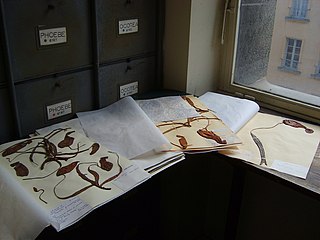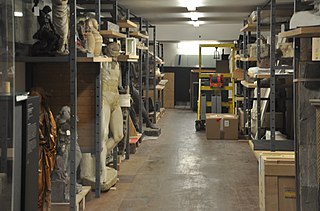
The International Standard Book Number (ISBN) is a numeric commercial book identifier which is intended to be unique. Publishers purchase ISBNs from an affiliate of the International ISBN Agency.
In computing, a namespace is a set of signs (names) that are used to identify and refer to objects of various kinds. A namespace ensures that all of a given set of objects have unique names so that they can be easily identified.
There are many different numbering schemes for assigning nominal numbers to entities. These generally require an agreed set of rules, or a central coordinator. The schemes can be considered to be examples of a primary key of a database management system table, whose table definitions require a database design.

An International Standard Serial Number (ISSN) is an eight-digit serial number used to uniquely identify a serial publication, such as a magazine. The ISSN is especially helpful in distinguishing between serials with the same title. ISSNs are used in ordering, cataloging, interlibrary loans, and other practices in connection with serial literature.

A herbarium is a collection of preserved plant specimens and associated data used for scientific study.

A digital object identifier (DOI) is a persistent identifier or handle used to identify objects uniquely, standardized by the International Organization for Standardization (ISO). An implementation of the Handle System, DOIs are in wide use mainly to identify academic, professional, and government information, such as journal articles, research reports, data sets, and official publications. However, they also have been used to identify other types of information resources, such as commercial videos.
In the United States, an ABA routing transit number is a nine-digit code printed on the bottom of checks to identify the financial institution on which it was drawn. The American Bankers Association (ABA) developed the system in 1910 to facilitate the sorting, bundling, and delivering paper checks to the drawer's bank for debit to the drawer's account.

The Arnold Arboretum of Harvard University, established in 1872, is the oldest public arboretum in North America. This botanical research institution and free public park is located in the Jamaica Plain and Roslindale neighborhoods of Boston, Massachusetts. The landscape was designed by Charles Sprague Sargent and Frederick Law Olmsted and is the second largest "link" in the Emerald Necklace. The Arnold Arboretum's collection of temperate trees, shrubs, and vines has a particular emphasis on the plants of the eastern United States and eastern Asia, where Arboretum staff and colleagues are actively sourcing new material on plant collecting expeditions. The Arboretum supports research in its landscape and in its Weld Hill Research Building.

A museum is distinguished by a collection of often unique objects that forms the core of its activities for exhibitions, education, research, etc. This differentiates it from an archive or library, where the contents may be more paper-based, replaceable and less exhibition oriented, or a private collection of art formed by an individual, family or institution that may grant no public access. A museum normally has a collecting policy for new acquisitions, so only objects in certain categories and of a certain quality are accepted into the collection. The process by which an object is formally included in the collection is called accessioning and each object is given a unique accession number.

Metadata is "data that provides information about other data". In other words, it is "data about data". Many distinct types of metadata exist, including descriptive metadata, structural metadata, administrative metadata, reference metadata and statistical metadata.
The Seed Herbarium Image Project (SHIP), is an initiative of the Arnold Arboretum of Harvard University to create a web-based repository of high-resolution digital images documenting the morphology of woody plant seeds and selected fruit structures. Headquartered at the Arboretum’s Dana Greenhouse facility and coordinated and photographed by curatorial assistant Julie McIntosh Shapiro, the Seed Herbarium Image Project supports the work of educators and professionals in horticulture and the botanical sciences, particularly in conservation research and management of rare and endangered species. The digitized images of seeds offer an important new aid for teaching seed identification—a fundamental skill in plant propagation, hybridization, and distribution—and serve as a resource for nurserymen, horticulturists, botanical curators, taxonomists, ecologists, and the general public. SHIP also provides an online resource for botanical institutions and nurseries to verify their collections and inventories. SHIP is made possible through the generous support of the Stanley Smith Horticultural Trust, Cabot Family Charitable Trust, and the J. Frank Schmidt Family Charitable Foundation.
The Handle System is the Corporation for National Research Initiatives's proprietary registry assigning persistent identifiers, or handles, to information resources, and for resolving "those handles into the information necessary to locate, access, and otherwise make use of the resources".
Thomas Walter was a British-born American botanist best known for his book Flora Caroliniana (1788), the first flora set in North America to utilize the Linnaean system of classification.

A scientific collection is a collection of items that are preserved, catalogued, and managed for the purpose of scientific study.

A collection manager ensures the proper care and preservation of objects within cultural institutions such as museums, libraries, and archives. Collection managers, along with registrars, curators, and conservators, play an important role in collections care. Collection Managers and Registrars are two distinct collection roles that are often combined into one within small to mid-size cultural institutions. Collection Managers can be found in large museums and those with a history and natural history focus whose diverse collections require experienced assessment to properly sort, catalog, and store artifacts. A collection manager may oversee the registrar, archivist, curator, photographer, or other collection professionals, and may assume the responsibilities of these roles in their absence within an organization.

Collections management involves the development, storage, and preservation of collections and cultural heritage. The primary goal of collections management is to meet the needs of the individual collector or collecting institution's mission statement, while also ensuring the long-term safety and sustainability of the cultural objects within the collector's care. Collections management, which consists primarily of the administrative responsibilities associated with collection development, is closely related to collections care, which is the physical preservation of cultural heritage. The professions most influenced by collections management include collection managers, registrars, and archivists.

A museum registrar is responsible for implementing policies and procedures that relate to caring for collections of cultural institutions like archives, libraries, and museums. These policies are found in the museum's collections policy, the guiding tenet of the museum explaining why the institution is in operation, dictating the museum's professional standards regarding the objects left in its care. Registrars focus on sections that include acquisitions, loans, exhibitions, deaccessions, storage, packing and shipping, security of objects in transit, insurance policies, and risk management.

The documentation of cultural property is a critical aspect of collections care. As stewards of cultural property, museums collect and preserve not only objects but the research and documentation connected to those objects, in order to more effectively care for them. Documenting cultural heritage is a collaborative effort. Essentially, registrars, collection managers, conservators, and curators all contribute to the task of recording and preserving information regarding collections. There are two main types of documentation museums are responsible for: records generated in the registration process—accessions, loans, inventories, etc. and information regarding research on objects and their historical significance. Properly maintaining both types of documentation is vital to preserving cultural heritage.
Linnaeus Link is an international collaboration between libraries with significant holdings of material by or relating to Carl Linnaeus (1707–1778), his students, and his legacy.

The conservation and restoration of herbaria includes the preventive care, repair, and restoration of herbarium specimens. Collections of dried plant specimens are collected from their native habitats, identified by experts, pressed, and mounted onto archival paper. Care is taken to make sure major morphological characteristics are visible. Herbaria documentation provides a record of botanical diversity.













